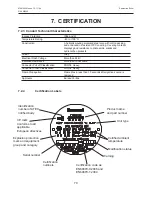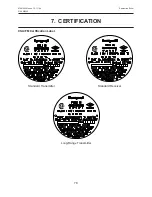
63
MAN0530 Issue 10 - 11/09
Searchline Excel
2104M0506
5. PROBLEM SOLVING
Fault/Problem
Causes
Remedies
Comms Error
Wrong communication mode
1) Select
Change Mode
option on the Interrogator.
reported by
selected on the Interrogator
2) Change the communication mode to
Excel
.
Interrogator
software
Interrogator software version
Version
1V00
Interrogator software to be
Excels
is incompatible
running
1V0
software.
with Excel software version
Version
2V0
Interrogator software can be used with
Excels running
2V0
software or higher.
Version
3V0
and
3V1
Interrogator software can be
used with Excels running
3V0
software or higher.
The latest version of Interrogator software is
greater than
4V0
. This version works with
3V0
and
higher Excels, Optima and Optima Plus. CSA
versions of the SHC-1 are programmed with
version 4V1 of the interrogator software, which
displays the units of measurement for the
Cross-Duct version as %LEL/m.
Incorrect communication
1) Check that Interrogator is correctly plugged
connection
into the IS socket on the DVC100(M) or DX100(M)
junction box.
2) Check that the RS485 A and B wires from the
Excel unit have been connected to the correct
terminals inside the DVC100(M) or DX100(M)
junction box.
Excel unit is not powered up
Check that the +24V supply is reaching Excel
unit correctly. The Supply voltage at unit should be
b18V and +32V.
Interrogator battery low
Check the Interrogator battery and replace if low.
See Appendix A. Section A.4.3.
I
nterrogator
The installation has failed to
1) Check that the signal levels reaching the
installation
meet the acceptable criteria
Receiver are greater than 0.7 and less than 2.0.
failed message
of the Instrument Assisted
2) Check that the correct range has been entered for
when attempting
Alignment (IAA) check
the installed path length.
initialisation
3) Check that the alignment of the
Receiver has been
fully optimised.
The received signals must be peaked up to the
maximum achievable. Adjusting the alignment until the
signals are just above the minimum signal threshold
and then leaving it at that is poor practice and will not
always result in an installation that passes the IAA
check criteria.
4) Check the alignment of the Transmitter.
5) Check that there are no objects obscuring part or all
of the beam path.
6) Check that the windows of both the Receiver and
the Transmitter are clean.
7) Check that the structures that the Transmitter and
Receiver are mounted on are stable and free from
significant angular movement/vibration.
8) Check that there is no gas in the beam - which
prevents successful zeroing.
9) Installation will fail in conditions of low visibility or
fluctuating atmospheric transmission - which degrade
signal quality. Do not attempt installation during
conditions of heavy rain, snow or fog.
















































